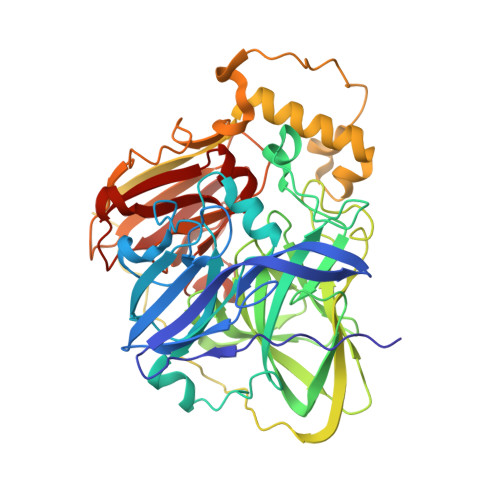Crystal structures of multicopper oxidase CueO bound to copper(I) and silver(I): functional role of a methionine-rich sequence.
Singh, S.K., Roberts, S.A., McDevitt, S.F., Weichsel, A., Wildner, G.F., Grass, G.B., Rensing, C., Montfort, W.R.(2011) J Biological Chem 286: 37849-37857
- PubMed: 21903583
- DOI: https://doi.org/10.1074/jbc.M111.293589
- Primary Citation of Related Structures:
3NSC, 3NSD, 3NSF, 3NSY, 3NT0, 3OD3 - PubMed Abstract:
The multicopper oxidase CueO oxidizes toxic Cu(I) and is required for copper homeostasis in Escherichia coli. Like many proteins involved in copper homeostasis, CueO has a methionine-rich segment that is thought to be critical for copper handling. How such segments function is poorly understood. Here, we report the crystal structure of CueO at 1.1 Å with the 45-residue methionine-rich segment fully resolved, revealing an N-terminal helical segment with methionine residues juxtaposed for Cu(I) ligation and a C-terminal highly mobile segment rich in methionine and histidine residues. We also report structures of CueO with a C500S mutation, which leads to loss of the T1 copper, and CueO with six methionines changed to serine. Soaking C500S CueO crystals with Cu(I), or wild-type CueO crystals with Ag(I), leads to occupancy of three sites, the previously identified substrate-binding site and two new sites along the methionine-rich helix, involving methionines 358, 362, 368, and 376. Mutation of these residues leads to a ∼4-fold reduction in k(cat) for Cu(I) oxidation. Ag(I), which often appears with copper in nature, strongly inhibits CueO oxidase activities in vitro and compromises copper tolerance in vivo, particularly in the absence of the complementary copper efflux cus system. Together, these studies demonstrate a role for the methionine-rich insert of CueO in the binding and oxidation of Cu(I) and highlight the interplay among cue and cus systems in copper and silver homeostasis.
- Department of Chemistry and Biochemistry, University of Arizona, Tucson, Arizona 85721, USA.
Organizational Affiliation:



















